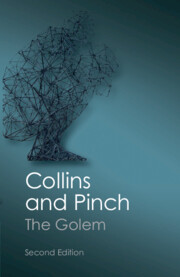Book contents
- Frontmatter
- Dedication
- Contents
- Preface to second edition
- Preface to first Canto edition
- Preface and acknowledgements
- Introduction: the golem
- 1 Edible knowledge: the chemical transfer of memory
- 2 Two experiments that ‘proved’ the theory of relativity
- 3 The sun in a test tube: the story of cold fusion 5
- 4 The germs of dissent: Louis Pasteur and the origins of life
- 5 A new window on the universe: the non-detection of gravitational radiation
- 6 The sex life of the whiptail lizard
- 7 Set the controls for the heart of the sun: the strange story of the missing solar neutrinos
- Conclusion: putting the golem to work
- Afterword: Golem and the scientists
- References and further reading
- Index
6 - The sex life of the whiptail lizard
Published online by Cambridge University Press: 05 February 2014
- Frontmatter
- Dedication
- Contents
- Preface to second edition
- Preface to first Canto edition
- Preface and acknowledgements
- Introduction: the golem
- 1 Edible knowledge: the chemical transfer of memory
- 2 Two experiments that ‘proved’ the theory of relativity
- 3 The sun in a test tube: the story of cold fusion 5
- 4 The germs of dissent: Louis Pasteur and the origins of life
- 5 A new window on the universe: the non-detection of gravitational radiation
- 6 The sex life of the whiptail lizard
- 7 Set the controls for the heart of the sun: the strange story of the missing solar neutrinos
- Conclusion: putting the golem to work
- Afterword: Golem and the scientists
- References and further reading
- Index
Summary
Introduction
David Crews, a professor of zoology and psychology at the University of Texas, might be thought of as a sexual voyeur. This is because he spends much of his time observing the bizarre sex lives of reptiles such as lizards and snakes. His work is of great interest to biologists. It is sometimes controversial. Our focus in this chapter is on one particular set of observations which Crews made of the mating behaviour of a particular species of whiptail lizard. However, by way of introduction to the sexual world of reptiles which Crews studies, we will first look at his less controversial work on the red-sided garter snake.
The Arctic environment of western Canada provides perhaps the harshest conditions encountered by any vertebrate on the planet. It is here that the red-sided garter snake lives. In order to survive the long Arctic winter, snakes have learnt the trick of cryopreservation. Their blood becomes extremely thick, and crucial bodily organs stop functioning almost completely, exhibiting barely detectable levels of activity. However, when Spring arrives, they undergo rapid transformation in preparation for mating.
Mating occurs over a short, intense period. The males emerge first from their long winter deep-freeze and spend from three days to three weeks basking in the sun near the entrance to the den. When the females emerge, either alone or in small groups, the males are attracted by a pherome (a messenger substance) on their backs.
- Type
- Chapter
- Information
- The GolemWhat You Should Know About Science, pp. 109 - 120Publisher: Cambridge University PressPrint publication year: 2012
- 1
- Cited by



